| URLs in this document have been updated. Links enclosed in {curly brackets} have been changed. If a replacement link was located, the new URL was added and the link is active; if a new site could not be identified, the broken link was removed. |
Project: Information Oasis
katherine.clemens@asu.edu
Emalee Craft
emalee.craft@asu.edu
Jennifer Duvernay
jennifer.duvernay@asu.edu
Sheila Hofstetter
sheila.hofstetter@asu.edu
Linda Shackle
linda.shackle@asu.edu
Science Reference Librarians
Arizona State University
Imagine a dry 105-degree day in the desert. It's your first day of classes -- you're hot, thirsty, and desperately trying to find your way around a large campus teeming with tens of thousands of people. Suddenly an image appears distantly down the sidewalk. You can't make it out at first, but slowly it comes into focus, a sign saying "LOST? Get Help Here!" Is it real or a mirage? As you approach you see smiling faces and people offering you free water -- you've indeed come across an oasis! And what is this place? It's a ... library? ... on the sidewalk!
Background
Comprised of in the Phoenix metropolitan area, Arizona State University is a research-intensive university with 12 colleges offering 230 degree programs from bachelor's through doctoral level. The Tempe campus is the largest of the four. Sitting on nearly 800 acres in downtown Tempe, over 49, 000 of our almost 60,000 Fall 2004 students take at least one class on this campus.Students, especially the new transfers and freshmen, frequently find this {large campus}, with its massive student body, daunting and hard to negotiate. The University has tried to alleviate some of these stresses by providing orientations and campus tours in the months leading up to the Fall Semester. Additionally, there are programs specifically for {new students} that introduce them to the many facets of the university community. Not every student takes advantage of these programs; even those that do can still feel lost.
The University Libraries, an ARL member, supports the Tempe Campus and works in conjunction with the libraries on the other campuses. The Noble Science and Engineering Library is a unit within the University Libraries and houses the science, engineering, nursing and map collections. Noble Library is not as familiar to the ASU community as is Hayden Library, which houses the humanities, social sciences, business and archive collections. Hayden, frequently perceived as the "Main Library," is located in the center of campus just steps from the student union. In the northeast section of campus, Noble Library is away from the bustling hub and is surrounded by the science and engineering complex of buildings. There is no undergraduate library on the campus.
We want to increase Noble Library's visibility, especially to those who are new to the University. We want students to discover a comfortable place with friendly staff who can assist them with their undergraduate science and engineering studies.
If the librarians have more personal contact with the students, we will be supporting the University's strategic goal of {increasing retention} as well as supporting our president's vision of a "New American University" (Crow 2002), especially Imperative #5: Focus on the Individual. Additionally, faculty's expectations of science and engineering students' research, even at the freshman and sophomore level, are higher than ever before. The proliferation of online resources has given the impression to some that scholarly literature is easy to find. The librarian's role is even more critical because of this.
Materials and Planning
Since Fall 2003, the Noble Science and Engineering Library has set up a welcome table at the start of each semester. Acting as a "greeter" just inside the library entrance, staff would assist students in finding their classes or any other type of "first day" information. Handmade signs outside directed "lost" students to the table. Students received a two-sided library flyer containing a campus map and marketing information for the library. Despite our best efforts, the number of assisted students were generally low, i.e., approximately 140 for the Fall 2003 semester.During the summer of 2004, the Noble Library hired three new reference librarians to replace those who had retired. These enthusiastic "fresh eyes" suggested going even more "out of the box" -- go outside the library to where the students were. Other improvements included better signage and promotional materials for new services at the library. The big draw, our "loss leader" as it is called in business, was to offer something free that every newcomer to the desert in August desperately needs --WATER!!
After several weeks of exploring new ideas, the new and improved plan for the project was finalized. As in previous semesters, we planned to distribute handouts. But this year we decided to provide a useful giveaway that would have a more lasting promotional impact. Since we were marking maps with highlighter pens, a valued student tool, we decided highlighters would also make a great giveaway. We ordered 500 two-colored markers in bulk with our customized messages imprinted on the barrel: "Ask a Librarian 24/7 www.asu.edu/lib," and "ASU Libraries."
![[highlighter pen]](clemens4.jpg)
Even though the highlighters were useful to the students, we knew that the free water would draw them to the "oasis". We purchased 500 half-liter bottles of spring water. While the free water showed the students we cared, we also wanted them to remember the nice library staff members. Taking advantage of every promotional opportunity, we created two catchy water-resistant labels to be placed on the water bottles. "Noble Science and Engineering Library -- Your Information Oasis" and "Noble Science and Engineering Library: Quench Your Thirst for Information."
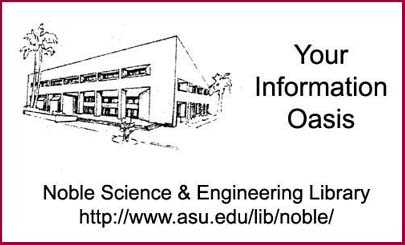
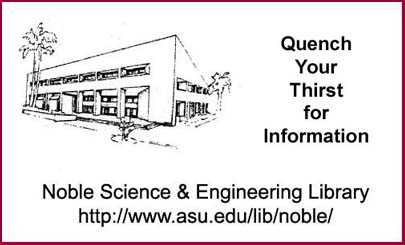
One important element in any promotional campaign is to get the attention of the intended audience. During the first week of classes, students expect to see tables with recruiters or solicitors selling cell phones or offering credit cards, but they do not expect to see helpful librarians with maps, directions, and free bottles of water. The handmade signs previously used did not attract sufficient attention or draw many students to our table inside the library. Our new plan called for a larger printed sign, more attractive and with a simple, easy-to-read message, "LOST? - GET HELP HERE!"
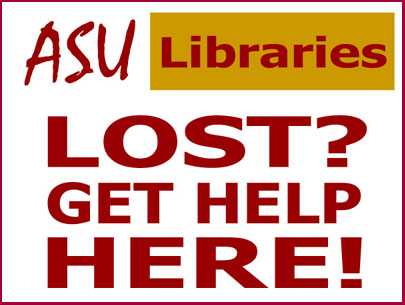
The new sign worked. Once we drew the students to the table, we identified ourselves as librarians with a large "ASK ME" nametag.
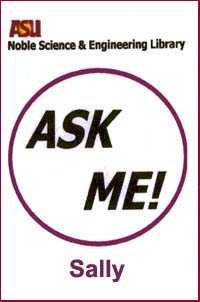
An added enhancement to our new 2004 improvements was a laptop computer that allowed us to take advantage of Noble Library's wireless network. The laptop allowed library staff and students quick access to online information related to course schedules, classroom changes, and department or staff contact information. Librarians were able to answer a broader range of questions. Just as the wireless laptop brought resources outside, so did a cell phone. The cell phone allowed us to answer those questions requiring a quick call to departments for further clarification or to call library staff for backup and supplies.
The total project cost was less than $500 for the water, ice, highlighters, labels and nametags. The library provided a table and wireless laptop, and library staff provided the shade tent and water coolers.
The Results
On August 23rd, 2004, 7:00 am, the day arrived to test the new improvements to our welcome table. The table was right out front near the sidewalk with its new sign, custom giveaways, flyers, laptop, coolers of chilled bottled water, and best of all -- Librarians.
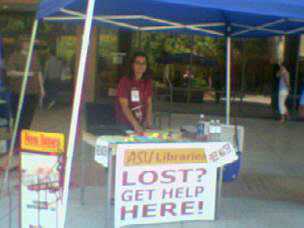
In just a short time, the students were arriving at our "oasis" in droves. We later realized that the shade tent had the unanticipated but positive result of increasing our visibility and drawing attention to our table. However, feedback from some students advised us that they thought we were yet another vendor selling cell phones; in the future we need to attach signage to the awning flap to identify us as the library. Our newly printed sign, attached to the front of the table, was not always visible due to the crowd of students in front; therefore better placement is needed. After the welcome table was taken down the new sign was put in a window by the entrance; easily seen from the sidewalk, it has been attracting students into the library ever since.
We staffed our welcome table on the first day of classes from 7:30 am to 3:00 pm, and from 7:30 am to 12:30 pm on the second day. We rotated librarians, at times needing three to staff the table. During the busiest times, we assisted nearly 50 students an hour and could not keep a complete count. We recorded 547, although this number is fewer than we actually served. In contrast, the 2003 total number of assisted students was 143.
The most frequently asked question was "where is my classroom or building?" We "individualized" each map using the giveaway highlighters to clearly mark the best route. We soon discovered that finding the lecture hall within the building was a source of great anxiety for many students, some lecture halls were notoriously difficult to find. We decided that we would increase our knowledge of the building interiors, i.e., key entrances, numbering systems, and locations of those hard to find lecture rooms, etc. Additionally, minimaps with directions to those lecture halls that are the most difficult to find, will be ready to distribute at our next welcoming event.
The students were grateful for the help and many stopped to take a break under the shade and talk with us. We had repeat customers -- on the first day (Monday) we helped students find their MWF classes and some returned on Tuesday for help finding their TTH classes. We even drew faculty to the table.
As for the water bottles, they were carried all around campus and into classrooms. Like a "most-wanted" flyer, the Noble Library's image was spread far and wide.
Summary
The 2004 welcome table improvements resulted in a greater number of students receiving assistance. This year's improvements included the outdoor location, quality signage, colorful shade tent, custom giveaways, and free bottled water. A laptop and cell phone increased options and sources for accessing the most current and complete information at the point-of-need and added that "tailored to the individual" service for which we were striving. Students learned where the Noble Library was, met library staff who demonstrated caring and interest, and received help at the point and time of a critical need. Since many students did ask for directions to the surrounding buildings and did receive information about undergraduate classes, we believe that our visibility was increased among undergraduates taking science and engineering classes.Future improvements to our process will include a larger table to accommodate more students. A new series of maps will be created to identify those hard to find lecture halls within the buildings. A second laptop is needed to accommodate the volume of questions at peak hours. A plan to purchase a customized canvas table sign and shade tent with the University Libraries brand will enhance the visual impact of our branding efforts, the professionalism of our display, and the ability to catch the student's eye. Additionally, we will explore ways to obtain a more accurate count of customers during peak times and to move beyond anecdotal assumptions to a valid assessment of our project's impact.
As we reviewed the 2004 event, we realized that it was a good way for the new staff to learn to answer a range of student questions related to directions, locations, schedules, and courses. Best of all, it was a great team building exercise. This is a successful process for raising visibility within our targeted population and encourages us to explore further ways to take the "oasis" to the students in the desert, truly and metaphorically speaking.
Acknowledgements
- Pam Cenzer, University of Florida, for giving Jennie Duvernay "big ideas,"
- Nina Walther, Library Specialist, Arizona State University, for designing our nametags.
- Sheila Young, Engineering Librarian, Arizona State University, for help staffing the table,
- Robert "BOB" Taskey, Library Specialist, Arizona State University, for being the team's official "water boy" and resident "Beast Of Burden,"
- Our custodial and circulation staff who helped in many tasks, before, during and after the event,
- And last, but not least, Chris Kolczyinski, Marc Mason, Bob Tasky, and Nina Walther who heroically agreed to staff our traditional, inside reference desk while the rest of us were outside having fun.
Bibliography
Crow, Michael. 2002. The New Gold Standard: Design Imperatives for the New American University. [Online] Available: {http://www.asu.edu/president/newamericanuniversity/} [October 14, 2004].
| Previous | Contents | Next |
